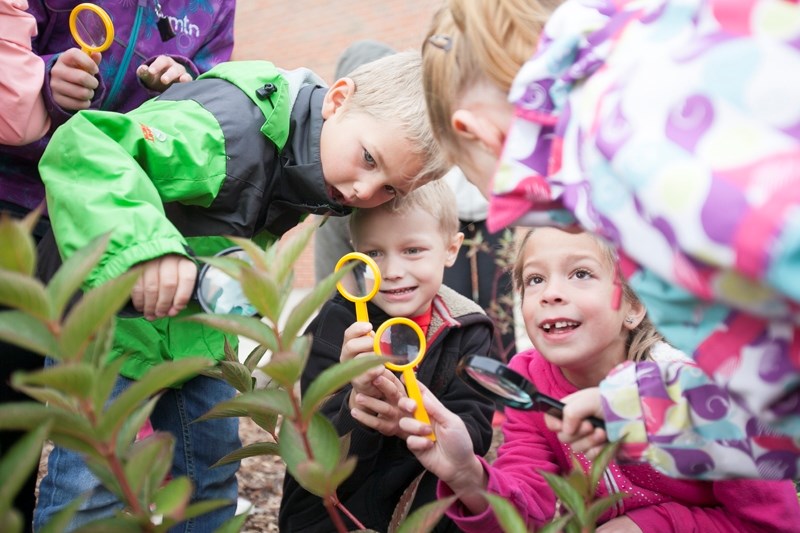Ecole Olds Elementary School teachers Helene Fisher and Debbie Unger can hardly contain their enthusiasm when they talk about a new learning garden and landscaped area at the front of the school.
With wooden benches, trees, shrubs and flowers, the garden is the natural space students wanted and the beautification feature the school needed, the teachers said.
Although the school was modernized in the last decade, Unger said, students felt the building's exterior didn't quite complement what was inside.
So, two years ago, Fisher, who has taught at the school for 32 years, and Unger, who has taught there for 22 years, began the process of planning and fundraising for a project that would spruce up the concrete walkway at the front of the school.
“It was time to do something,” Fisher said.
In the past, she said, the school has attempted to create a natural learning space at the rear of the school but it was difficult to sustain due to vandalism.
The teachers, who each teach grades 1 and 2, therefore started brainstorming ideas for a natural learning space concept for the front of the school with their students.
“There's a whole different level of respect with the front of the school,” Fisher said, adding she and Unger wanted a space where students could take a break and learn about nature and where parents could wait for their children at the end of the school day.
“You see how many people meet their kids outside,” Unger said.
The teachers also wanted vegetation that would attract the insects and animals students were learning about in school as well as rocks that were included in the school's curriculum.
“It isn't just what you learn out there, it's about being part of the outside world,” Fisher said.
Once they had a basic outline of what the space should include, Fisher and Unger pitched the idea to fourth-year students in Olds College's sustainable landscape design course.
Four college students took on the project for credit in their course and, along with speaking with OES students, parents and neighbours of the school, they prepared surveys that OES students distributed to the community asking for input on the learning space concept.
When they had drafted a set of plans for the project, the college students presented their designs to OES with ideas about what vegetation could survive in the space with little water, sunlight or maintenance and what elements would be the most appealing to the school and the community.
Fisher said OES took the plan and made a handful of changes such as reducing the number of trees and increasing the number of flowers.
With the plan approved, the school embarked on 12 months of fundraising.
The school held a number of events such as a family sock hop to bring in cash and the school's parent council provided $4,000, with another $5,000 coming from the Olds Lions Club.
And six- and seven-year-old students at the school collected recycling from classrooms every day, eventually bringing in $3,700 from the deposits on juice and milk cartons.
In the end, the school raised $16,500 and many local businesses and organizations donated materials, time and expertise to the project.
Overall, Fisher and Unger said the students in their classes really took “ownership” of the project, from the design to the fundraising, and they were excited to see the garden take shape.
When work finally began on the project last school year, teachers and their families, students, farmers and local contractors all helped out, with many of the children at the school helping with cleaning and maintaining the space and planting the trees and flowers.
All of the shrubs and trees are native to Alberta, Unger said, and some of them were transplanted from local gardens.
Fisher added that the vegetation had to be drought resistant since there's no school in the summer.
Most of the work on the garden was completed in May with the final touches, including the pouring of a concrete curb, finished in August.
And there's enough money leftover from the fundraising effort to sustain the natural space, replace plants as necessary and install a rain collection system.
Now, Fisher said, students and staff at the school are enjoying the space.
“Staff say they like the smell of the cedar, they like seeing the space from their windows while they're working.”
And many students are happy to have a place to go at the school outside the classroom where they can see nature in action.
“It's nice because we saw birds, ladybugs, lots of insects, butterflies and it makes our school more interesting to see and we can study there about how the plants grow,” said Grade 2 student Chance Bullock.
His classmate, Ashlyn Ord, agreed that the new garden gives the front of the school a whole new character.
“It's amazing and it makes better life and plants are good for you,” she said. “There's much more growing things and you can see how nature grows.”
Unger and Fisher are proud the entire school participated in the project and they said the benefits of the natural learning space to the school's students and the community go well beyond the present.
“It's not just about here and now,” Fisher said, adding she wanted to create a legacy at the school for future students and staff. “It's about many years to come.”




